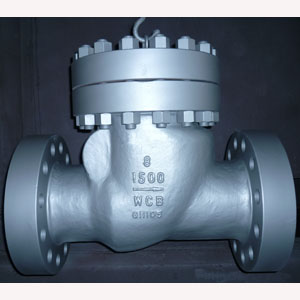Classification and function of check valve
Posted: 06/17/2020 17:56:35 Hits: 46
Check valves can be divided into swing check valves and lift check valves. Swing check valves can only be installed on horizontal pipes, while lift check valves can be installed on both horizontal and vertical pipes.

First, look at the consequences of a pump without a check valve:
The water flow in the water outlet pipe of the pump changes suddenly due to the opening or closing of the valve and stopping of the pump, etc., leading to a sudden change in the flow rate in the pipe, and in turn causing a change in momentum per unit time, which inevitably produces a corresponding inertial force. As a result, the pressure in the pipeline alternates between a sudden rise and a sudden drop. This phenomenon of water flow velocity and pressure changing with time and position is called water hammer.
The water hammer of the pumping station includes valve opening water hammer, valve closure water hammer and pump-stopping water hammer (due to sudden power failure and other reasons). The first two types of water hammer will not cause problems that endanger the safety of the unit under normal operating procedures. The water hammer pressure value formed by the latter is often very large, which causes an accident.
The purpose of studying water hammer and calculating water hammer is:
① Prepare protective measures when the maximum water hammer pressure causes damage to pipelines and units;
② Set the minimum water hammer pressure which could cause unacceptable negative pressure in the pipeline and draw up protective measures when the pipeline is damaged;
③ Prevent the damage caused by the unit reverse.
In the pumping system, the characteristics of the pump are the boundary conditions at the beginning of the pipeline. If there is no check valve at the outlet of the pump, and there is no shutter at the outlet of the pipeline, when the pump is stopped in an accident, the pump loses its driving force, the gate valve on the outlet side of the pump cannot be closed in time. The water hammer process (or hydraulic transition process) occurs when the water in the pipeline flows backward.
1. Pump operating conditions
After the pump loses power, the speed of the pump drops sharply. The water flow in the pump and the outlet pipe continues to move in the original direction due to inertia, but its flow rate decreases rapidly and the pressure drops until the water flow stops
Flowing forward and the flow rate is zero. At this moment, the pump is still rotating forward, and the water flow is flowing positive (the movement of the water from the pump to the outflow pool is called positive flow), which is called pump working condition.
2. Braking working conditions
In the transient static water body with zero flow in the outlet pipe, due to the effect of the static head of the outlet pool, a reverse water flow from the outlet pool to the pump is generated in the outlet pipe. The reverse water flow has a braking effect on the pump impeller that is still rotating forward, forcing the speed of the rotor of the unit to decrease rapidly until the speed is zero. At this moment, due to the resistance of the impeller rotating forward to the reverse flow, the pump outlet pressure gradually increased. The transient working condition of the pump at this moment is called the braking working condition.
3. Hydraulic turbine operating conditions
With the increase of reverse water flow, the pump starts to reverse from the speed of zero and rises rapidly. At the same time, the centrifugal force of the rotating impeller on the water flow also increases, which hinders the reverse water flow.
This resistance increases with the acceleration of the reverse rotation of the impeller, so that the pressure behind the pump rises rapidly, reaches a maximum value at a certain moment, and its corresponding reverse speed also reaches the maximum value. While the resistance increases, it also resists the continued increase of the reverse water flow. After reaching a certain maximum value, it gradually decreases.
The energy acting on the impeller is correspondingly reduced, so that the reverse speed gradually decreases until the torque of the water flow on the impeller is balanced with the resistance torque of the rotating part of the unit under the action of a stable static water head. The unit works like a hydraulic turbine at a constant reverse flow and speed without any load, and the water hammer pressure disappears. This transient operating condition is called hydraulic turbine operating condition.
The above is the consequence of the pump without check valve. At the same time, the pressure change after the pump will be in the form of a water hammer wave along the outlet pipe toward the outlet tank, and then reflected back from the outlet tank, forming a complex water hammer phenomenon in the outlet pipe. Water hammer-proof check valves can be used.
